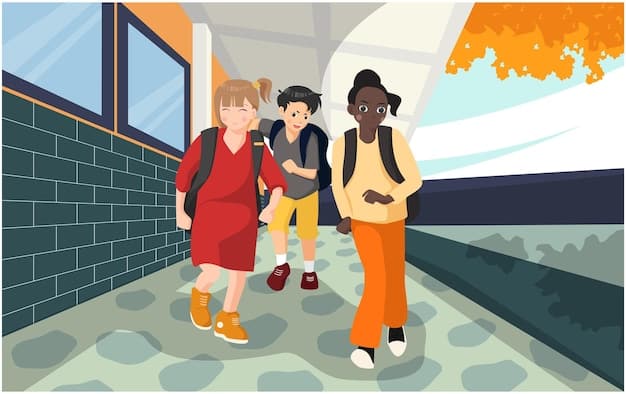School Zone Advocacy: How to Get Involved and Make a Difference

School Zone Advocacy: How to Get Involved and Make Your Voice Heard involves active participation in improving safety, policies, and the overall educational environment around schools, ensuring a better and more secure community for children.
Are you passionate about ensuring the safety and well-being of children in your community? School Zone Advocacy: How to Get Involved and Make Your Voice Heard is easier than you think. This article provides a comprehensive guide to help you advocate for safer, healthier, and more supportive school zones.
Understanding School Zone Advocacy
School zone advocacy is about taking action to improve the environment around our schools. It encompasses a wide range of activities aimed at enhancing the safety, health, and overall quality of life for students and their families. By getting involved, you can help create a more nurturing and secure community for everyone.
Advocacy in this context means speaking up and working towards positive change. It might involve addressing traffic concerns, promoting healthier food options, or pushing for better infrastructure. The goal is to ensure that the areas surrounding schools are conducive to learning and development.
Why School Zone Advocacy Matters
Safe and supportive school zones are crucial for fostering a positive educational environment. When children feel safe and secure, they are more likely to thrive academically and socially. Advocacy helps to create these conditions, benefiting not only students but also the wider community.
Engaging in school zone advocacy can lead to tangible improvements, such as reduced traffic congestion, safer pedestrian crossings, and increased access to green spaces. These changes can have a profound impact on the well-being of students and residents alike.
- Enhanced Safety: Advocacy can lead to measures that protect children from traffic accidents and other hazards.
- Improved Health: Promoting healthier food options and active transportation can combat childhood obesity and promote overall well-being.
- Stronger Communities: Advocacy fosters a sense of unity and shared responsibility among residents, creating a more cohesive community.
In essence, school zone advocacy is about creating environments where children can learn, play, and grow without unnecessary risks. It’s a proactive approach to community development that yields long-term benefits for everyone involved.

By participating, you contribute to a legacy of care and commitment, ensuring that future generations have access to safer and more supportive school zones. Your voice matters, and your actions can make a significant difference in the lives of countless children.
Identifying Key Issues in Your School Zone
Before diving into advocacy, it’s essential to identify the specific issues that need addressing in your school zone. This involves careful observation, data collection, and community engagement. A thorough understanding of the challenges will help you develop targeted and effective advocacy strategies.
Start by taking a walk around the school zone during peak hours. Observe traffic patterns, pedestrian behavior, and any potential hazards. Note areas where children may be at risk, such as busy intersections or poorly maintained sidewalks.
Traffic Safety Concerns
Traffic safety is often a primary concern in school zones. Issues such as speeding, distracted driving, and inadequate pedestrian crossings can pose significant risks to children. Identifying these problems is the first step towards finding solutions.
Consider conducting a traffic survey to gather data on vehicle speeds and traffic volume. This information can be used to support your advocacy efforts and demonstrate the need for change. Share your findings with local authorities and community members to raise awareness and build support.
- Speeding: Monitor vehicle speeds and identify areas where speeding is prevalent.
- Distracted Driving: Observe drivers for signs of distraction, such as cell phone use.
- Pedestrian Crossings: Assess the safety and visibility of pedestrian crossings.
Beyond traffic, assess the state of sidewalks and bike lanes. Poorly maintained infrastructure can create additional hazards for students who walk or bike to school. Document any areas that require repair or improvement and include them in your advocacy agenda.
Community engagement is crucial for identifying all relevant issues. Talk to parents, teachers, and students to gather their perspectives on the challenges they face in the school zone. These conversations can uncover problems that you may not have noticed on your own.
By combining your observations with input from the community, you can create a comprehensive list of issues that need addressing. This list will serve as a roadmap for your advocacy efforts, guiding you towards targeted and effective solutions.
Building a Coalition: Working with Others
Advocacy is most effective when it’s a collaborative effort. Building a coalition of like-minded individuals can amplify your voice and increase your chances of success. Working with others brings diverse perspectives and skills to the table, making your advocacy efforts more robust and impactful.
Start by reaching out to parents, teachers, and school administrators. These individuals have a vested interest in improving the school zone and are likely to be supportive of your efforts. Organize meetings to discuss your concerns and brainstorm potential solutions.
Engaging Community Leaders
Community leaders, such as local council members, business owners, and neighborhood association representatives, can be valuable allies in your advocacy efforts. Their support can help you gain access to resources and influence decision-making processes.
Invite community leaders to participate in your meetings and events. Share your data and observations with them, and explain how their involvement can benefit the community. Highlight the positive impact that school zone improvements can have on local businesses and property values.
- Local Council Members: Seek their support for policy changes and funding allocations.
- Business Owners: Partner with them to promote safe and healthy behaviors in the school zone.
- Neighborhood Associations: Collaborate with them to mobilize residents and raise awareness.
In addition to engaging community leaders, consider partnering with local organizations that share your goals. Environmental groups, health advocacy organizations, and transportation advocacy groups can provide expertise and resources to support your efforts.
Remember that building a coalition takes time and effort. Be patient and persistent in your outreach, and focus on building strong relationships with your partners. By working together, you can create a powerful force for positive change in your school zone.

Ultimately, a successful coalition is built on shared values and a common vision. By uniting diverse stakeholders around the goal of improving the school zone, you can create a lasting impact that benefits the entire community.
Strategies for Effective Advocacy
Once you have identified the issues and built a coalition, it’s time to develop a strategic approach to advocacy. This involves setting clear goals, identifying your target audience, and choosing the right tactics to achieve your objectives. Effective advocacy requires careful planning and consistent effort.
Start by defining your goals. What specific changes do you want to see in the school zone? Are you aiming to reduce traffic speeds, improve pedestrian safety, or promote healthier food options? Clearly defined goals will help you focus your efforts and measure your progress.
Communicating Your Message
Effective communication is essential for successful advocacy. Crafting a compelling message that resonates with your target audience is crucial for gaining support and influencing decision-makers. Tailor your message to address the specific concerns and priorities of your audience.
Use a variety of communication channels to reach your target audience, including social media, email, and community meetings. Create visually appealing materials, such as infographics and videos, to convey your message in an engaging and memorable way.
- Social Media: Use platforms like Facebook and Twitter to share updates, engage with your community, and promote your events.
- Email: Create an email list to keep your supporters informed and mobilize them to take action.
- Community Meetings: Organize public forums to discuss your concerns and gather feedback from residents.
In additional to effective communication, direct engagement with decision-makers is essential. Attend town hall meetings, write letters to elected officials, and schedule meetings to discuss your concerns. Be prepared to present your data and evidence in a clear and persuasive manner.
Remember that advocacy is a marathon, not a sprint. Be patient and persistent in your efforts, and celebrate your successes along the way. By staying focused on your goals and working collaboratively with your coalition, you can achieve lasting change in your school zone.
In conclusion, effective advocacy combines clear goals, strategic communication, and consistent engagement. By mastering these elements, you can amplify your voice and make a significant difference in the lives of students and families in your community.
Working with Local Government and School Boards
Collaborating with local government and school boards is vital for implementing meaningful changes in your school zone. These entities have the authority to enact policies, allocate funding, and enforce regulations that can significantly impact the safety and well-being of students. Building strong relationships with these decision-makers is essential for successful advocacy.
Start by understanding the structure and processes of your local government and school board. Identify the key individuals who are responsible for making decisions related to transportation, education, and public safety. Learn about their priorities and agendas, and look for opportunities to align your advocacy efforts with their goals.
Presenting Your Case
When meeting with government officials and school board members, be prepared to present your case in a clear and compelling manner. Use data and evidence to support your claims, and highlight the potential benefits of your proposed solutions. Focus on the positive impact that your recommendations can have on the community.
Tailor your presentation to the specific interests and concerns of your audience. Emphasize the ways in which your proposals align with their priorities and contribute to their objectives. By demonstrating that your advocacy efforts can help them achieve their goals, you increase the likelihood of gaining their support.
- Be Prepared: Gather data, prepare talking points, and anticipate potential questions.
- Be Persuasive: Highlight the benefits of your proposals and address any concerns.
- Be Professional: Maintain a respectful and courteous tone throughout the meeting.
Beyond formal meetings, nurture informal relationships with government officials and school board members. Attend community events, participate in public forums, and engage in casual conversations. These interactions can help you build rapport and foster a sense of trust and mutual understanding, making it easier to collaborate on future initiatives.
Remember that government and school board decisions are often influenced by public opinion. Mobilize your coalition to attend meetings, write letters, and contact elected officials to express their support for your proposals. A strong show of community support can sway decision-makers and increase the likelihood of positive outcomes.
In summary, effective collaboration with local government and school boards requires understanding their structures, presenting your case persuasively, and building strong relationships. By working together in a spirit of partnership, you can create lasting improvements in your school zone.
Measuring and Celebrating Success
Demonstrating the impact of your advocacy efforts is crucial for maintaining momentum and securing ongoing support. Measuring your successes helps you track your progress, identify areas for improvement, and communicate the value of your work to stakeholders. Celebrating your achievements boosts morale and reinforces the importance of your efforts.
Start by establishing clear metrics for measuring success. These metrics should align with your advocacy goals and reflect the specific changes you are trying to achieve. For example, if your goal is to reduce traffic speeds in the school zone, your metrics might include average vehicle speeds, number of speeding violations, and pedestrian safety ratings.
Tracking Your Progress
Use a variety of methods to track your progress, including surveys, traffic counts, and observational studies. Collect data before and after implementing your advocacy initiatives to assess their impact. Analyze the data to identify trends and patterns, and use your findings to refine your strategies.
Share your results with your coalition, community leaders, and the public. Create reports, presentations, and social media posts to communicate your successes. Highlight the positive impact that your advocacy efforts have had on the safety, health, and well-being of students and families.
- Surveys: Gather feedback from parents, teachers, and students about their experiences in the school zone.
- Traffic Counts: Monitor vehicle speeds and traffic volume to assess the effectiveness of traffic calming measures.
- Observational Studies: Observe pedestrian behavior and identify potential safety hazards.
In addition to measuring your successes, it’s important to celebrate your achievements. Organize events to recognize the contributions of your coalition members, volunteers, and supporters. Share stories of the positive impact that your work has had on the community. These celebrations reinforce the importance of your efforts and inspire others to get involved.
Remember that advocacy is an ongoing process. Even after achieving your initial goals, continue to monitor the situation and identify new challenges. Stay engaged with your community, and advocate for continuous improvement in your school zone.
In conclusion, measuring and celebrating success is essential for sustaining your advocacy efforts. By tracking your progress, sharing your results, and recognizing the contributions of your supporters, you can build momentum and create a lasting impact on your community.
| Key Point | Brief Description |
|---|---|
| 🚦 Traffic Safety | Reducing speeding and improving pedestrian crossings. |
| 🤝 Coalition Building | Working together with parents, teachers, and leaders. |
| 📢 Effective Communication | Crafting compelling messages for different audiences. |
| 📊 Measuring Success | Tracking progress and celebrating achievements. |
Frequently Asked Questions
School zone advocacy involves taking action to improve the area around schools, focusing on safety, health, and overall quality of life for students, families, and the community.
Observe traffic, pedestrian behavior, and potential hazards during peak hours. Talk to parents, teachers, and students to gather their perspectives and identify concerns.
Include parents, teachers, school administrators, community leaders, local council members, business owners, neighborhood association representatives, and relevant organizations.
Define clear goals, craft compelling messages, utilize various communication channels, engage decision-makers directly, and mobilize your coalition for meetings and public forums.
Establish clear metrics, track progress using surveys and observational studies, share your results with stakeholders, and celebrate your achievements to maintain momentum and support.
Conclusion
Engaging in school zone advocacy is a powerful way to protect our children. From identifying key issues and mobilizing community support to working with local government and school boards and constantly measuring and celebrating successes, there are many ways to get involved and make sure your voice is heard. So take the first step today and become a champion for safe, healthy, and thriving school zones in your community, paving the way to the creation of safer environments.





